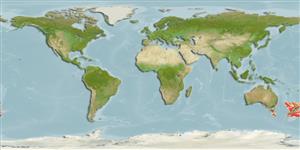Teleostei (teleosts) >
Gadiformes (Cods) >
Macrouridae (Grenadiers or rattails)
Etymology: Coryphaenoides: Greek, koryphaina = dolphin fish + Suffix oides = similar to (Ref. 45335).
More on author: Günther.
Environment: milieu / climate zone / depth range / distribution range
Ecology
Marine; bathydemersal; non-migratory; depth range 540 - 2070 m (Ref. 1371). Deep-water; 33°S - 50°S, 137°E - 179°W (Ref. 1371)
Southwest Pacific: New Zealand, Tasman Sea, south of Tasmania, southeast Australia (Victoria), and possibly also across the Indian Ocean (Ref. 1371). A possible subspecies, Coryphaenoides serrulatus oceanus from the Indian Ocean (Walters Shoals south of Madagascar to Broken Ridge in 870-1,255 m) is recognized by Iwamoto and Shcherbachev (Ref. 10993).
Size / Weight / Age
Maturity: Lm ? range ? - ? cm
Max length : 48.2 cm TL male/unsexed; (Ref. 71794)
Dorsal spines (total): 2; Anal spines: 0. Head of moderate-size, its underside scaled; sensory pores on head prominent; eyes relatively large; snout blunt, its tip and lateral angles with large, stout tubercular scutes. Scales adherent, densely covered with distinctly shield-shaped imbricate spinules. Pyloric caeca short, directed anteriorly, 10 to 12; retia mirabilia 6. Overall color is brownish gray; fins dusky; oral and branchial cavities blackish.
Body shape (shape guide): elongated; Cross section: circular.
A benthic species (Ref. 75154) recorded from the continental slope (Ref. 9563, 75154).
Life cycle and mating behavior
Maturity | Reproduction | Spawning | Eggs | Fecundity | Larvae
Cohen, D.M., T. Inada, T. Iwamoto and N. Scialabba, 1990. FAO species catalogue. Vol. 10. Gadiform fishes of the world (Order Gadiformes). An annotated and illustrated catalogue of cods, hakes, grenadiers and other gadiform fishes known to date. FAO Fish. Synop. 125(10). Rome: FAO. 442 p. (Ref. 1371)
IUCN Red List Status (Ref. 130435: Version 2025-1)
Threat to humans
Harmless
Human uses
Fisheries: minor commercial
Tools
Special reports
Download XML
Internet sources
Estimates based on models
Preferred temperature (Ref.
123201): 3.1 - 7.2, mean 4.8 °C (based on 181 cells).
Phylogenetic diversity index (Ref.
82804): PD
50 = 0.5000 [Uniqueness, from 0.5 = low to 2.0 = high].
Bayesian length-weight: a=0.00214 (0.00109 - 0.00421), b=3.20 (3.03 - 3.37), in cm total length, based on LWR estimates for this (Sub)family-body shape (Ref.
93245).
Trophic level (Ref.
69278): 3.5 ±0.4 se; based on size and trophs of closest relatives
Resilience (Ref.
120179): Low, minimum population doubling time 4.5 - 14 years (Preliminary K or Fecundity.).
Fishing Vulnerability (Ref.
59153): Moderate vulnerability (38 of 100).
🛈
